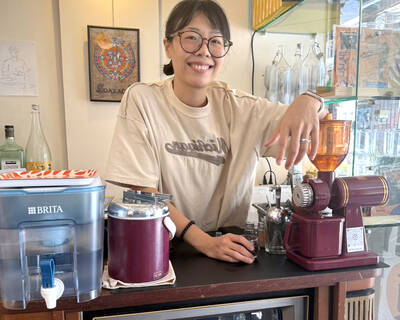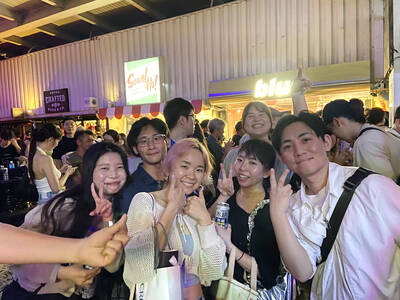The Royal Ballet won a whole new legion of fans with its visit to the National Theater, which more than lived up to the expectations that had been building since its visit was first announced in December.
The Mixed Bill program and Giselle were in both impressive productions, in very different ways, but in the end in came down to the dancers, who were simply superb. The decision to open the Taipei tour with the mix of Wayne McGregor’s Choma, Sir Frederick Ashton’s Raphsody and Chrisopher Wheeldon’s DVG was spot on: McGregor’s piece served notice that this was not your parents’ Royal Ballet, Ashton’s gave the audience a vision of what they think the Royal is, while Wheeldon’s showed what the Royal actually is now.
Chroma is set in a clinically sparse, yet glowing cube (by John Pawson), with tall walls and a large rectangular cutout in the back. The 10 dancers on Friday night — Lauren Cuthbertson, Yuhui Choe, Sarah Lamb, Melissa Hamilton, Ricardo Cervera, Paul Kay, Eric Underwood, Jonathan Watkins, Edward Watson and Dawid Trzensimiech — arched, contorted and distorted their bodies in ways that often looked completely inhuman and yet were oddly familiar. Often the pairings looked like the mating rituals of some elongated stick insect, especially in the lifts and carries, when the women would spread their legs wide, but with the feet angled in sharply. And yet there was a softness in some of the pas de deux. McGregor’s choreography built on the tensions and power of Joby Talbot’s arrangements of White Stripe songs.

Photo: Diane Baker, Taipei times
Steven McRae shone in Rhapsody, which is really all about the male danseur, since his partner — the exquisite Alina Cojocaru — doesn’t enter until about halfway through. Set to Serge Rachmaninoff’s Rhapsody on a Theme of Paganini, the piece is filled with flashy moves for the male lead, but with plenty of fast footwork for the six-couple ensemble as well.
DVG is a 29-minute journey of pure bliss. Everything about it was perfect: the soaring, pulsating score by Michael Nyman (his 1993 composition commemorating the inauguration of France’s TVG trains, MGV: Musique a Grade Vitesse), the masterful choreography that showed Wheeldon’s lineage — George Balanchine’s geometric pattern-making, the humanity and accessibility of Jerome Robbins and Ashton’s romance and lyricism — and the eight lead dancers: Laura Morera, Nathalie Harrison, Itziar Mendizabal, Cuthbertson, McRae, Ryoichi Hirano, Gary Avis and Nehemiah Kish. Each of the lead pairs has a distinctive look, while the 16-member ensemble — who begin packed together like commuter sardines — later expand to lines that arch and weave in rolling waves of motion.
When the company performs this work at home there is a massive silvery sculptural set piece, but DVG works just as well on a bare stage, thanks to the great lighting design by Jennifer Tipton. DVG is a jubilant piece that lingers in the mind long after the performance is over, just as the four female leads, carried by their partners, linger on stage, slowing spinning after the music has stopped.
The Saturday matinee of Giselle showed the purity of line and storytelling the Royal is famous for. I have never seen a Giselle in which the storytelling is so clear, from the mime in Act I to the moment in Act II when Giselle places herself, arms outstretched, in front of Albrecht, to protect him from the wrath of Myrtha and her Wilis, who throw their arms over their heads and curve away in terror.
Roberta Marquez was a delightful, but fragile Giselle to Thiago Soares’ Albrecht, while Thomas Whitehead as Hilarion was more a jealous stalker than lovesick youth. Also notable were Hikaru Kobayashi as Myrtha and Akane Takada and Kenta Kura, who were the lead couple in the Pas de six in Act I.
Now that the Royal has wrapped up its first visit to Taiwan, let’s hope it won’t take another centennial anniversary before the company is seen here again.

Cheng Ching-hsiang (鄭青祥) turned a small triangle of concrete jammed between two old shops into a cool little bar called 9dimension. In front of the shop, a steampunk-like structure was welded by himself to serve as a booth where he prepares cocktails. “Yancheng used to be just old people,” he says, “but now young people are coming and creating the New Yancheng.” Around the corner, Yu Hsiu-jao (饒毓琇), opened Tiny Cafe. True to its name, it is the size of a cupboard and serves cold-brewed coffee. “Small shops are so special and have personality,” she says, “people come to Yancheng to find such treasures.” She

In July of 1995, a group of local DJs began posting an event flyer around Taipei. It was cheaply photocopied and nearly all in English, with a hand-drawn map on the back and, on the front, a big red hand print alongside one prominent line of text, “Finally… THE PARTY.” The map led to a remote floodplain in Taipei County (now New Taipei City) just across the Tamsui River from Taipei. The organizers got permission from no one. They just drove up in a blue Taiwanese pickup truck, set up a generator, two speakers, two turntables and a mixer. They

Former Chinese Nationalist Party (KMT) chairwoman Hung Hsiu-chu’s (洪秀柱) attendance at the Chinese Communist Party’s (CPP) “Chinese People’s War of Resistance Against Japanese Aggression and the World Anti-Fascist War” parade in Beijing is infuriating, embarrassing and insulting to nearly everyone in Taiwan, and Taiwan’s friends and allies. She is also ripping off bandages and pouring salt into old wounds. In the process she managed to tie both the KMT and the Democratic Progressive Party (DPP) into uncomfortable knots. The KMT continues to honor their heroic fighters, who defended China against the invading Japanese Empire, which inflicted unimaginable horrors on the

Hannah Liao (廖宸萱) recalls the harassment she experienced on dating apps, an experience that left her frightened and disgusted. “I’ve tried some voice-based dating apps,” the 30-year-old says. “Right away, some guys would say things like, ‘Wanna talk dirty?’ or ‘Wanna suck my d**k?’” she says. Liao’s story is not unique. Ministry of Health and Welfare statistics show a more than 50 percent rise in sexual assault cases related to online encounters over the past five years. In 2023 alone, women comprised 7,698 of the 9,413 reported victims. Faced with a dating landscape that can feel more predatory than promising, many in